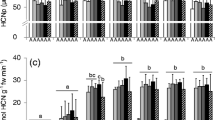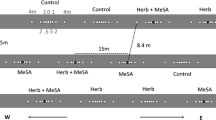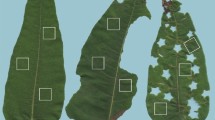Abstract
Plants express inducible direct and indirect defenses in response to herbivory. The plant hormone jasmonic acid (JA) and related signaling compounds referred to as jasmonates play a central role in regulating defense responses to a wide range of herbivores.We assessed whether treating tomato seeds with 0.8 mM of methyl jasmonate (MeJA) affected the performance of the leaf miner Tuta absoluta, and whether possible changes in volatile profiles altered the behavior of its predator Chrysoperla externa. MeJA-treatment significantly lengthened larval development and decreased the pupal weight of T. absoluta. Herbivory alone increased the emissions of α-pinene, 6-methyl 5-hepten-2-one, β-myrcene, (E)-β-ocimene, isoterpinolene, TMTT, (Z)-3-hexenyl butyrate, and hexyl salicylate. MeJA seed treatment significantly decreased the emissions of α-cubebene from undamaged and herbivore-infested plants. In addition, the emissions of several compounds were lower in the absence of herbivory. Chrysoperla. externa preferred odors from herbivore-infested plants over those from control plants, regardless of the MeJA-treatment, and they did not show any preference for herbivore-infested plants for any of the MeJA-treatments. Our results show preliminary evidence that the treatment of tomato seeds with MeJA can reduce the performance of Tuta absoluta, and that the chemical differences observed in plant VOC profiles do not alter the behavior of the model predator.


Similar content being viewed by others
References
Agrawal AA, Karban R (1999) Why induced defenses may be favored over constitutive strategies in plants. In: Tollrian R, Harvell CD (eds) The ecology and evolution of inducible defenses. Princeton University Press, Princeton, pp 45–61
Akter N, Okuma E, Sobahan MA, Uraji M, Munemasa S, Nakamura Y, Mori IC, Murata Y (2013) Negative regulation of methyl jasmonate-induced stomatal closure by glutathione in Arabidopsis. J Plant Growth Regul 32:208–215
Ament K, Kant MR, Sabelis MW, Haring MA, Schuurink RC (2004) Jasmonic acid is a key regulator of spider mite-induced volatile terpenoid and methyl salicylate emission in tomato. Plant Physiol 135:2025–2037
Bleeker PM, Diergaarde PJ, Ament K, Guerra J, Weidner M, Schütz S, De Both MTJ, Haring MA, Schuurink RC (2009) The role of specific tomato volatiles in tomato-whitefly interaction. Plant Physiol 151:925–935
Boughton AJ, Hoover K, Felton GW (2005) Methyl jasmonate application induces increased densities of glandular trichomes on tomato, Lycopersicon esculentum. J Chem Ecol 31:2211–2216
Bruinsma M, Posthumus MA, Mumm R, Mueller MJ, van Loon JJA, Dicke M (2009) Jasmonic acid-induced volatiles of Brassica oleracea attract parasitoids: effects of time and dose, and comparison with induction by herbivores. J Exp Bot 60:2575–2587
Buzi A, Chilosi G, De Sillo D, Magro P (2004) Induction of resistance in melon to Didymella bryoniae and Sclerotinia sclerotiorum by seed treatments with acibenzolar‐S‐methyl and methyl jasmonate but not with salicylic acid. J Phytopathol 152:34–42
Conrath U, Beckers GJ, Flors V et al (2006) Priming: getting ready for battle. Mol Plant Microbe Interact 19:1062–1071
De Moraes CM, Lewis WJ, Paré PW, Alborn HT, Tumlinson JH (1998) Herbivore-infested plants selectively attract parasitoids. Nature 393:570–573
De Moraes CM, Mescher MC, Tumlinson JH (2001) Caterpillar-induced nocturnal plant volatiles repel conspecic females. Nature 410:577–580
Dicke M, Takabayashi J, Posthumus MA, Schütte C, Krips OE (1998) Plant-phytoseiid interactions mediated by herbivore-induced plant volatiles: variation in production of cues and in responses of predatory mites. Exp Appl Acarol 22:311–333
Dudareva N, Negre F, Nagegowda DA, Orlova I (2006) Plant volatiles: recent advances and future perspectives. Crit Rev Plant Sci 25:417–440
El-Wakeil N, Gaafar N, Sallam A, Volkmar C (2013) Side effects of insecticides on natural enemies and possibility of their integration in plant protection strategies. In: Trdan S (ed). Insecticides—Development of Safer and More Effective Technologies, InTech, pp. 3–56.
Embrapa (2014) Cultivo de Tomate para Industrialização http://sistemasdeproducao.cnptia.embrapa.br/FontesHTML/Tomate/TomateIndustrial_2ed/index.htm Accessed 9 June 2014.
Faraq MA, Paré PW (2002) C6-Green leaf volatiles trigger local and systemic VOCemissions in tomato. Phytochemistry 61:545–554
Farmer EE, Ryan CA (1992) Octadecanoid precursors of jasmonic acid activate the synthesis of wound-inducible proteinase inhibitors. Plant Cell 4:129–134
Farooq M, Aziz T, Basra SMA, Cheema MA, Rehman H (2008) Chilling tolerance in hybrid maize induced by seed priming with salicylic acid. J Agron Crop Sci 194:161–168
Felton GW, Donato K, Del Vecchio RJ, Duffey SS (1989) Activation of plant foliar oxidases by insect feeding reduces nutritive quality of foliage for noctuid herbivores. J Chem Ecol 15:2667–2694
Fenemore P (1977) Oviposition of potato tuber moth, Phthorimaea operculella Zell. (Lepidoptera: Gelechiidae); fecundity in relation to mated state, age, and pupal weight. N Z J Zool 4:187–191
Ghoneim K (2014) Predatory insects and arachnids as potential biological control agents against the invasive tomato leafminer, Tuta absolutaMeyrick(Lepidoptera: Gelechiidae), in perspective and prospective. J Entomol Zool Stud 2:52–71
Girling RD, Hassall M (2008) Behavioural responses of the seven-spot ladybird Coccinella septempunctata to plant headspace chemicals collected from four crop Brassicas and Arabidopsis thaliana, infested with Myzus persicae. Agric For Entomol 10:297–306
Girling RD, Stewart-Jones A, Dherbecourt J, Staley JT, Wright DJ, Poppy GM (2011) Parasitoids select plants more heavily infested with their caterpillar hosts: a new approach to aid interpretation of plant headspace volatiles. Proc R Soc B 278:2646–2653
Hodge S, Galster AM, Ward JL, Beale MH, Powell G (2011) The effects of a plant defence priming compound, β-aminobutyric acid, on multitrophic interactions with an insect herbivore and a hymenopterous parasitoid. BioControl 56:699–711
Honěk A (1993) Intraspecific variation in body size and fecundity in insects: a general relationship. Oikos 483–492
Tuta absoluta Information Network (2014) http://www.tutaabsoluta.com/tuta-absoluta. Accessed 29 January 2014.
Kant MR, Ament K, Sabelis MW, Haring MA, Schuurink RC (2004) Differential timing of spider mite-induced direct and indirect defenses in tomato plants. Plant Physiol 135:483–495
Karban R (2011) The ecology and evolution of induced resistance against herbivores. Funct Ecol 25:339–347
Karban R, Baldwin IT (1997) Induced responses to herbivory. University of Chicago Press, Chicago
Kennedy GG (2003) Tomato, pests, parasitoids and predators: Tritrophic interactions involving the genus Lycopersicon. Annu Rev Entomol 48:51–72
Kesselmeier J, Staudt M (1999) Biogenic volatile organic compounds (VOC):an overview on emission, physiology and ecology. J Atmos Chem 33:23–88
Kessler A, Baldwin IT (2002) Plant responses to insect herbivory: the emerging molecular analysis. Annu Rev Plant Biol 53:299–328
Krantev A, Yordanova R, Janda T, Szalai G, Popova L (2008) Treatment with salicylic acid decreases the effect of cadmium on photosynthesis in maize plants. J Plant Physiol 165:920–931
Leather SR (1988) Size, reproductive potential and fecundity in insects: things aren’t as simple as they seem. Oikos 51:386–389
Li L, van Staden J, Jäger AK (1998) Effects of plant growth regulators on the antioxidant system in seedlings of two maize cultivars subjected to water stress. Plant Growth Regul 25:81–87
Lietti MM, Botto E, Alzogaray RA (2005) Insecticide resistance in Argentine populations of Tuta absoluta (Meyrick)(Lepidoptera: Gelechiidae). Neotrop Entomol 34:113–119
Loughrin JH, Manukian A, Heath RR, Turlings TCJ, Tumlinson JH (1994) Diurnal cycle of emission of induced volatile terpenoids by herbivore-injured cotton plants. Proc Natl Acad Sci U S A 91:11836–11840
Martins CB, Zarbin PHG (2013) Volatile organic compounds of conspecific-damaged Eucalyptus benthamii influence responses of mated females of Thaumastocoris peregrinus. J Chem Ecol 39:602–611
Mithöfer A, Boland W (2012) Plant defense against herbivores: chemical aspects. Annu Rev Plant Biol 63:431–450
Pankaj, Muttucumaru N, Powers SJ, Gaur HS, Kurup S, Curtis RHC (2013) Differential defence response due to jasmonate seed treatment in cowpea and tomato against root-knot and potato cyst nematodes. Nematology 15:15–21
Pinto-Zevallos DM, Zarbin PHG (2013) A química na agricultura: perspectivas para o desenvolvimento de tecnologias sustentáveis. Quim Nova 36:1509–1513
Pinto-Zevallos DM, Martins CB, Pellegrino AC, Zarbin PHG (2013) Compostos orgânicos voláteis na defesa induzida das plantas contra insetos herbívoros. Quim Nova 36:1395–1405
Price PW, Bouton CE, Gross P, McPheron BA, Thompson JN, Weis AE (1980) Interactions among three trophic levels: influence of plants on interactions between insect herbivores and natural enemies. Annu Rev Ecol Syst 11:41–65
Proffit M, Birgersson G, Bengtsson M, Reis R Jr, Witzgall P, Lima E (2011) Attraction and oviposition of Tuta absoluta females in response to tomato leaf volatiles. J Chem Ecol 37:565–574
Seenivasagan T, Chander S, Navarajan Paul AV (2009) Orientation and behavioural responses of Cotesia plutellae Kurdjumov (Hymenoptera: Braconidae) to cruciferous host plants and host larval body extracts. J Biol Control 23:365–373
Shakirova FM, Sakhabutdinova AR, Bezrukova MV, Fatkhutdinova RA, Fatkhutdinova DR (2003) Changes in the hormonal status of wheat seedlings induced by salicylic acid and salinity. Plant Sci 164:317–322
Silva GA, Picanço MC, Bacci L, Crespo AL, Rosado JF, Guedes RN (2011) Control failure likelihood and spatial dependence of insecticide resistance in the tomato pinworm, Tuta absoluta. Pest Manag Sci 67:913–920
Siqueira H, Guedes R, Picanço MC (2000) Cartap resistance and synergism in populations of Tuta absoluta (Lep., Gelechiidae). J Appl Entomol 124:233–238
Smart LE, Martin JL, Limpalaër M, Bruce TJ, Pickett JA (2013) Responses of herbivore and predatory mites to tomato plants exposed to jasmonic acid seed treatment. J Chem Ecol 39:1297–1300
Smith JL, De Moraes CM, Mescher MC (2009) Jasmonate- and salicylate-mediated plant defense responses to insect herbivores, pathogens and parasitic plants. Pest Manag Sci 65:497–503
Stenberg JA, Lehrman A, Björkman C (2010) Uncoupling direct and indirect plant defences: novel opportunities for improving crop security in willow plantations. Agric Ecosyst Environ 139:528–533
Stout MJ, Zehnder GW, Bauer ME (2002) Potential for the use of elicitors of plant resistance in arthropod management programs. Arch Insect Biochem Physiol 51:222–235
Thaler JS (1999) Jasmonate-inducible plant defences cause increased parasitism of herbivores. Nature 399:686–688
Thaler JS, Farag MA, Paré PW, Dicke M (2002) Jasmonate‐deficient plants have reduced direct and indirect defences against herbivores. Ecol Lett 5:764–774
Traw BM, Dawson TE (2002) Differential induction of trichomes by three herbivores of black mustard. Oecologia 131:526–532
Turlings TCJ, Wäckers F (2004) Recruitment of predators and parasitoids by herbivore-injured plants. In: Cardé RT, Millar JG (eds) Advances in insect chemical ecology. Cambridge University Press, Cambridge, pp 21–75
van Dam NM, Witjes L, Svatoš A (2004) Interactions between aboveground and belowground induction of glucosinolates in two wild Brassica species. New Phytol 161:801–810
van Poecke RMP, Dicke M (2002) Induced parasitoid attraction by Arabidopsis thaliana: involvement of the octadecanoid and the salicylic acid pathway. J Exp Bot 53:1793–1799
Villas Bôas GL, Castelo Branco M, Medeiros MA (2009) Manejo integrado da traça-do-tomateiro (Tutaabsoluta) em sistema de produção integrada de tomate indústria (PITI). 16 p. Brasília:Embrapa Hortaliças (Circular Técnica 73)
Worrall D, Holroyd GH, Moore JP, Glowacz M, Croft P, Taylor JE, Paul ND, Roberts MR (2012) Treating seeds with activators of plant defence generates long‐lasting priming of resistance to pests and pathogens. New Phytol 193:770–778
Wu J, Baldwin IT (2009) Herbivory‐induced signalling in plants: perception and action. Plant Cell Environ 32:1161–1174
Acknowledgments
The authors thank Liah A. D. Ferreira for treating all seeds used in the experiment, and for taking care of the plants before the experiments, Dr. Päivi Tiiva for statistical support, Dr. Brigida Souza for supplying Chrsyoperla externa eggs for starting the rearing, Flavia Krechemer for providing us with eggs and pupae of Tuta absoluta, and Samantha Husmann for support in the analysis of trichomes. Prof. Saskya van Nouhuys has kindly read the manuscript for improving the language. Conselho Nacional de Desenvolvimento Científico e Tecnológico (CNPq) – Proc. No. 401928/2012-8, Coordenação de Aperfeiçoamento de Pessoal de Nível Superior (CAPES) e Instituto Nacional de Ciências e Tecnologia (INCT) de Semioquímicos na Agricultura and USAID Cooperative Agreement No: EPP-A-00-0400016-00 are acknowledged for financial support. D.P-Z. is currently funded by the Program Science Without Borders.
Author information
Authors and Affiliations
Corresponding author
Rights and permissions
About this article
Cite this article
Strapasson, P., Pinto-Zevallos, D.M., Paudel, S. et al. Enhancing Plant Resistance at the Seed Stage: Low Concentrations of Methyl Jasmonate Reduce the Performance of the Leaf Miner Tuta absoluta but do not Alter the Behavior of its Predator Chrysoperla externa . J Chem Ecol 40, 1090–1098 (2014). https://doi.org/10.1007/s10886-014-0503-4
Received:
Revised:
Accepted:
Published:
Issue Date:
DOI: https://doi.org/10.1007/s10886-014-0503-4




